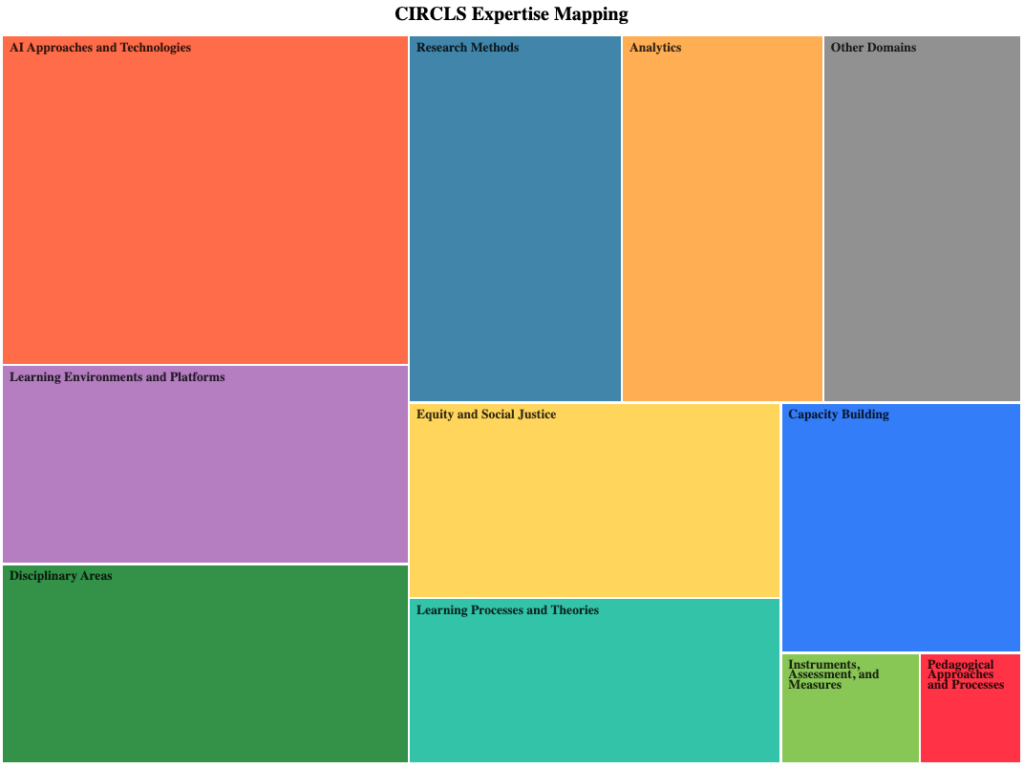- Executive Summary
- Introduction
- Existing Partnership Trends
- Transformations
- Partnership Structures
- Building Capacity
- Conclusion
- Acknowledgments
Existing Partnership Trends in the CIRCLS Community
by Aditi Mallavarapu and Shari Gardner
Our community is formed by the awards made in NSF research programs, and thus to understand the community, it is important to begin with the solicitations (i.e. calls for proposals). The Cyberlearning and RETTL solicitations invited proposals for futuristic exploratory innovations in learning and teaching technology from cross-disciplinary teams with complementary perspectives. In response, researchers from computer science, learning sciences, educational psychology, and many other domains have come together both as project teams and across projects to form a research community over the decade.
To increase our understanding of the research taking place within the community, including the types of partnerships being formed, the CIRCLS team administers a project survey to PIs of newly awarded RETTL projects. Based on the most recent responses from 35 RETTL projects, about 80 percent of projects include collaborations or partnerships. A majority of these projects reported that they partner with educators or practitioners (66 percent). Responses indicated that these projects partner with educators or practitioners to actively engage them in the co-design of new tools, curricula, and technologies; conduct needs sensing to inform development; and to engage educators as research participants in usability or pilot testing and as early adopters of new tools and technologies. Other project partnerships include those with schools or districts (34 percent), community organizations (14 percent), and/or Minority Serving Institutions (MSIs) (six percent) to engage teachers and learners in the iterative design and development of new technologies and/or to be the implementation setting of the formal and informal learning experiences being developed and tested. Projects also indicated partnering specifically with schools or organizations that exclusively serve students with disabilities to engage these students throughout co-design, development, and testing and to ensure that the tools and technologies being developed meet the needs of all students. Lastly, the few projects that indicated that they partner with MSIs said that they are collaborating with these institutions as research partners.
The CIRCLS Community Network
To further characterize the research contributions from this community, the CIRCLS team collected data on project collaborations and conducted an analysis that allowed us to (1) visualize investigator relationships and research collaborations, and (2) map the interdisciplinary contributions.
We used the names of Principal Investigators (PIs) and Co-PIs listed as NSF awardees between 2011-2022 to visualize the research community. The PIs and Co-PIs constitute the nodes, and the collaborations between them are represented as edges (see Figure 1a or access the interactive network by Aditi Mallavarapu, Digital Promise). The network depicts 1133 researchers connected as 279 sub-networks. This includes nine influential members (awarded more than five grants) embedded in the larger subnetwork which connects 62 members together as a subnetwork (see Figure 1b).
To further understand how the community was evolving, we visualized the new members in red nodes. These new members joined the community in teams, and to a lesser extent, as collaborators with existing members of the community. This growth of the network opens possibilities for CIRCLS to integrate these members to form a more inclusive community.

Figure 1a: Collaboration network of CIRCLS community as of 2022. Nodes represent PI and Co-PI, and their collaboration is represented as edges. New PIs and Co-PIs are represented in red.
Mapping Interdisciplinary Community Expertise

Community expertise treemap. Each tile represents the proportional number of members that contribute to the respective tag, the color of the tile depicts the high-level category of that tag.
To understand the expanse of the cross-disciplinary research contributions of this community, in early 2021 the CIRCLS team developed a tag-based framework, hierarchically arranged within 10 major categories of interest. We manually cataloged research expertise from 145 recent RETTL awardees, from their professional websites and curriculum vitae. We re-coded the collected information using the tag-based framework as a starting point to create a treemap of research expertise of the community where each tile represents a tag, with the size of the tag representing the proportional number of members that identify the tag as their expertise, and the color of the tile depicting the high-level category or block of that tag. The treemap by Hanzhang (Jen) Wang, University of Pittsburgh shows that 20 percent of the community indicated that they have expertise in AI approaches and technologies (see blue tiles on left), with learning environments and technologies closely following this category at 15%. The community also includes expertise outside of educational research, bringing in domain and state-of-art technology development expertise (see “other domain” block below), while also contributing to equity and social justice oriented projects (see “social justice” block). With the prolific emergence of AI-oriented chat applications, a notable observation is the growing expertise in narrative learning environments, where learning environments mediate narrative-based learning via AI enabled technology.
Future Directions
In future work, the co-occurrences among these tags is being analyzed to understand the different genres of interdisciplinary research in the CIRCLS community. These insights could allow us to (1) understand the nature of the interdisciplinary collaborations within CIRCLS and support it by brokering connections amongst community members, (2) identify the strengths and potential gaps in project areas to suggest exciting opportunities for new investigations, and 3) reveal tag-based similarities and synergies between existing projects.

 Download the CIRCLS 2023 Community Report (PDF)
Download the CIRCLS 2023 Community Report (PDF)